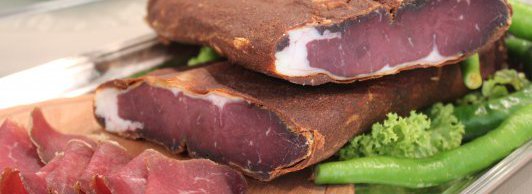
History of Pastırma
The nomad Turks of Central Asia has developed many methods to preserve their surplus food. Some of these methods and the foodstuff discovered based on these methods have survived until the current times. “Pastırma” the salt cured, air dried beef is one of these food stuffs that is inherited from the Central Asian Turks.
The Turkic tribes, who lived in the steps of Central Asia, before 11th Century A.D., have salted and air dried their leftover meats in order to preserve. Due to their nomadic nature, the dried meat were stored in leather bags and consumed as necessary. Weber Baldamus mentioned in his world history book, based on the information obtained from Amiadus of Antioch (273-375), the Hun Turks consumed the flesh of the freshly hunted animals as well as meat that was mixed with various wild herbs and preserved by placing it under the saddles where the meat would be pressed by their legs as they rode. However the author is not informed correctly. The Huns actually stored the meats in the pockets found on the saddles. Therefore the meat never touched the body of the horse. This information is clearly stated in the old sources of the Huns located in the Hungarian National Museum.
The oldest meat preservation method is to salt and air-dry the meat in the sun. Different cultures of the world have different meat preservation methods. The method used to make “pastırma” is invented by the Central Asian Turks, and it is the forerunner of today’s “pastırma”, a term which literally means ‘being pressed’ in Turkish.
Looking into the old scripts, such as “Divan-ü Lügat-it Türk”, the first Turkish- Arabic dictionary written by Mahmoud al-Kashgari, the word “pastırma” was not used. Instead “basturmak” was used, which means to place something under a very heavy object. In the Turkish language used by the Central Asian Turks, there were other words such as “kedhirilmek” or “kakaç” used which means dried meat, and the word “kak” was used for everything dried.
Based on the information from “Divan-ü Lügat-it Türk,” during autumn, meat would be mixed with some spices, dried and stored until spring. During spring the animals would lose weight and their meat becomes flavorless. Therefore those who have stored up some “pastırma” would have access to good tasty meat.
Arrival of “pastırma” in Anatolia was especially well received in the city of Kayseri. The 17th century Turkish traveler Evliya Çelebi, praised “pastırma” of Kayseri in his Book of Travels, and Kayseri “pastırma” is still regarded as the finest of all. Although there are several other cities that are known to make “pastırma,” Kayseri is the only one that is associated with this delicacy. Due to the fact that, it is an important trade that passes from generation to generation, the climate of Kayseri and the high amounts of nitrate found in the city water also plays a very important role in this matter.
Good quality “pastırma” is a delicacy with a wonderful flavor. Although “pastırma” can also be made with mutton or goat’s meat, beef is preferred. During the Ottoman period, although they almost always consumed lamb in their dishes, when making “pastırma” beef was the meat of choice.
[1] 2 next page »